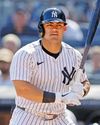
If the 2019 college season had ended after just four weeks, it would have been hard to see Missouri outfielder Kameron Misner as anything other than a top-10 pick.
Through the first four weeks of last season, before Southeastern Conference play began, Misner hit .393 (22-for-56) with five home runs, 20 walks and just 10 strikeouts. All while boasting above-average or better tools across the board.
If the 2018 college season had ended after just four weeks, it would have been hard to see Virginia lefthander Daniel Lynch as a first-round selection.
Lynch posted a 4.68 ERA over his first four starts against Central Florida, Eastern Kentucky, Yale and Duke, with average stuff across the board and a middling collegiate track record overall.
Neither of those four-week samples told the complete story. Misner went on to struggle against SEC competition with an approach that was deemed too passive, while Lynch showed an uptick in stuff and control late in the season and turned in a dominant Atlantic Coast Conference tournament outing just before the draft.
In the end, Lynch was selected at the back of the first round by the Royals, with the 34th overall selection, while Misner went one pick and one year later in 2019, when the Marlins took him with their supplemental first-round pick at No. 35.
The two players are different in almost every way but were taken in the same range for different reasons and illustrate examples of why early-season evaluations can be incomplete at best and misleading at worst.
In both situations, teams had every piece of the puzzle to figure them out. They simply needed to put those pieces together to the best of their abilities. But what happens when you don’t know if all the pieces are in the box?
この記事は Baseball America の May/June 2020 版に掲載されています。
7 日間の Magzter GOLD 無料トライアルを開始して、何千もの厳選されたプレミアム ストーリー、9,000 以上の雑誌や新聞にアクセスしてください。
すでに購読者です ? サインイン
この記事は Baseball America の May/June 2020 版に掲載されています。
7 日間の Magzter GOLD 無料トライアルを開始して、何千もの厳選されたプレミアム ストーリー、9,000 以上の雑誌や新聞にアクセスしてください。
すでに購読者です? サインイン

THE SERVICE TIME CONUNDRUM
MLB’s byzantine service time rules cloud rookie status and now PPI eligibility

LUIS TIANT WAS MLB'S MOST SUCCESSFUL CUBAN PITCHER
On a scouting trip to Cuba in 1957, Bobby Avila discovered 16-year-old righthander Luis Tiant on the island's Juvenile League all-star team.

ORGANIZATION REPORT
Outfielder Heston Kjerstad's career has been unique, to say the least.

TOP 10 NL EAST
From the moment Thomas White stepped on a high school mound, he was viewed as the top lefthander available in the 2023 draft.

PREPARATION PAYS OFF
lowa politician J.D. Scholten makes a surprising return to pro ball at age 44

MAKING THE GRADE
Assessing the future value of graduated National League prospects

TOP 10 NL WEST
Even in high school, Bryce Eldridge could hit the ball a mile. The 6-foot-7 righthander could also touch 96 mph off the mound.

Wood Has Towering Upside- Nationals rookie James Wood also stands 6-foot-7 and also has game-changing power.
Aaron Judge and Oneil Cruz are 6-foot7 sluggers who stand out for their power in this year’s MLB Best Tools voting. Wood spent half of this season with Triple-A Rochester before making his MLB debut on July 1. While he was in the International League, he captured managers’ attention. Wood unanimously won Best Power Prospect and also claimed Most Exciting Player in a survey of league skippers. Wood hit .353/.463/.595 with 10 home runs in 52 games for Rochester. His .242 isolated slugging was the best for a player 21 or younger at Triple-A this season.

ROAD BLOCK?
Scholarship expansion puts mid-majors at a major disadvantage on the road to Omaha

ROYALS REVIVAL
A revamped and rejuvenated farm system has Kansas City ready to rebound